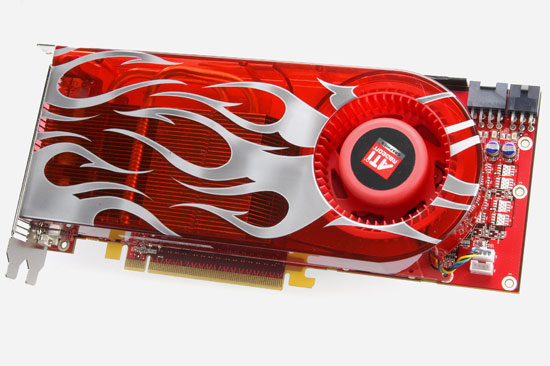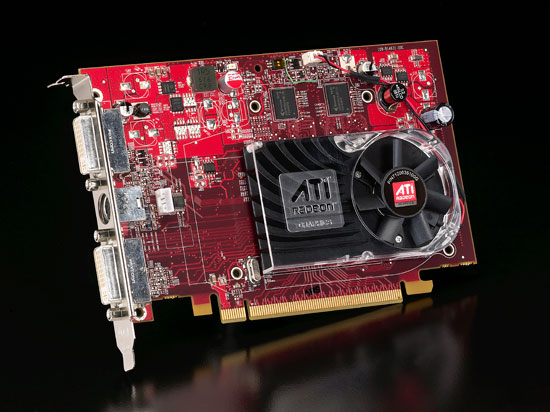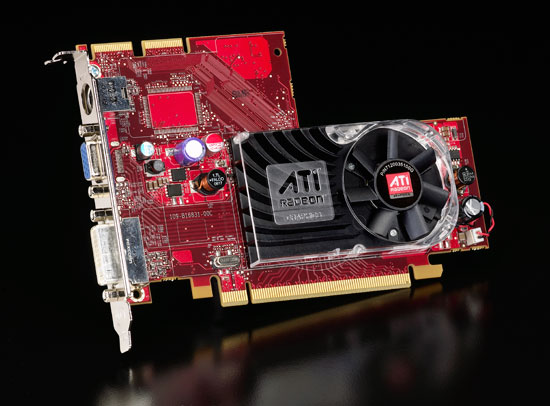ATI Radeon HD 2900 XT: Calling a Spade a Spade
by Derek Wilson on May 14, 2007 12:04 PM EST- Posted in
- GPUs
The AMD HD 2000 Series Lineup
The announcement today includes a top-to-bottom lineup of DX10 class hardware including four mobile parts (with one additional DX9 mobile part sharing the HD 2000 series naming) and five desktop parts. While all of this hardware is being made public, we've only got one piece of hardware to bring to the table today: the R600 based Radeon HD 2900 XT.

Performance on all other R6xx parts won't be available until "late June", but we can still talk about what these parts will be when they finally make it to market. On the desktop, in addition to the HD 2900 XT, we will see the Radeon HD 2400 Pro and XT in the "value" segment, with the HD 2600 Pro and XT providing good mainstream-to-midrange gaming performance.
ATI Radeon HD 2600 XT

ATI Radeon HD 2400 XT

ATI Radeon HD 2400 Pro

There is currently no add-in retail hardware planned that tops the HD 2900 XT, but we are hearing rumors that faster parts may be available through OEMs only. This is unconfirmed at present, so take it with a grain of salt. Let's take a look at a break down of what we do know we'll be getting:
| AMD R6xx Hardware | ||||||||
| SPs | RBEs | Core Clock | TMUs | DDR Rate | Bus Width | Memory Size | Price | |
| HD 2900 XT | 320 | 16 | 740MHz | 16 | 825MHz | 512bit | 512MB | $399 |
| HD 2600 | 120 | 4 | 600 - 800MHz | 8 | 400 - 1100MHz | 128bit | 256MB | $99 - $199 |
| HD 2400 | 40 | 4 | 525 - 700MHz | 4 | 400 - 800MHz | 64bit | 128MB / 256MB | <$99 |
It's harder to pin down all the specs of the mobile parts, as all the clock speeds (and sometimes bus width) can change depending on the TDP envelope a notebook maker is working with. While we aren't certain, our best guess is that mobile parts named similarly to desktop parts will have the same internal configuration of SPs, texture units, and render back ends. The exception here is the Mobility Radeon HD 2300, which is a DX9 part based on R5xx hardware.
While 2400 and 2600 standard and XT versions will exist in the mobile space, there are currently no plans for a high end mobile part. This is very likely due to the high power draw and low performance per watt we see with AMD's 80nm R600. We don't expect to see a higher performance mobile part until AMD can get the power consumption of its higher end hardware down (likely with a process shrink).
Just for comparison, let's take a look at what NVIDIA is currently offering as well. Here's a table of all the G8x based parts on the market.
| NVIDIA G8x Hardware | ||||||||
| SPs | ROPs | Core Clock | Shader Clock | DDR Rate | Bus Width | Memory Size | Price | |
| 8800 Ultra | 128 | 24 | 612MHz | 1.5GHz | 2.16GHz | 384bit | 768MB | $830+ |
| 8800 GTX | 128 | 24 | 576MHz | 1.35GHz | 1.8GHz | 384bit | 768MB | $600 - $650 |
| 8800 GTS | 96 | 20 | 513MHz | 1.19GHz | 1.6GHz | 320bit | 640MB | $400 - $450 |
| 8800 GTS 320MB | 96 | 20 | 513MHz | 1.19GHz | 1.6GHz | 320bit | 320MB | $300 - $350 |
| 8600 GTS | 32 | 8 | 675MHz | 1.45GHz | 2GHz | 128bit | 256MB | $200 - $230 |
| 8600 GT | 32 | 8 | 540MHz | 1.19GHz | 1.4GHz | 128bit | 256MB | $150 - $160 |
| 8500 GT | 16 | 4 | 450MHz | 900MHz | 800MHz | 128bit | 256MB / 512MB | $89 - $129 |










86 Comments
View All Comments
yyrkoon - Tuesday, May 15, 2007 - link
See, the problem here is: guys like you are so bent on saving that little bit of money, by buying a lesser brand name, that you do not even take the time to research your hardware. USe newegg , and read the user reviews, and if that is not enough for you, go to the countless other resources all over the internet.yyrkoon - Tuesday, May 15, 2007 - link
Blame the crappy OEM you bought the card from, not nVIdia. Get an EVGA card, and embrace a completely different aspect on video card life.MSI may make some decent motherboards, but their other components have serious issues.
LoneWolf15 - Thursday, May 17, 2007 - link
Um, since 95% of nvidia-GPU cards on the market are the reference design, I'd say your argument here is shaky at best. EVGA and MSI both use the reference design, and it's even possible that cards with the same GPU came off the same production line at the same plant.DerekWilson - Thursday, May 17, 2007 - link
it is true that the majority of parts are based on reference designs, but that doesn't mean they all come from the same place. I'm sure some of them do, but to say that all of these guys just buy completed boards and put their name on them all the time is selling them a little short.at the same time, the whole argument of which manufacturer builds the better board on a board component level isn't something we can really answer.
what we would suggest is that its better to buy from OEMs who have good customer service and long extensive warranties. this way, even if things do go wrong, there is some recourse for customers who get bad boards or have bad experiences with drivers and software.
cmdrdredd - Monday, May 14, 2007 - link
you're wrong. 99% of people buying these high end cards are gaming. Those gamers demand and deserve the best possible performance. If a card that uses MORE power and costs MORE (x2900xt vs 8800gts) and performs generally the same or slower what is the point? Fact is...ATI's high end is in fact slower than mid range offerings from Nvidia and consumes alot more power. Regardless of what you think, people are buying these based on performance benchmarks in 99% of all cases.AnnonymousCoward - Tuesday, May 15, 2007 - link
No, you're wrong. Did you overlook the emphasis he put on "NOT ALWAYS"?You said 99% use for gaming--so there's 1%. Out of the gamers, many really want LCD scaling to work, so that games aren't stretched horribly on widescreen monitors. Some gamers would also like TVout to work.
So he was right: faster is NOT ALWAYS better.
erwos - Monday, May 14, 2007 - link
It'd be nice to get the scoop on the video decode acceleration present on these boards, and how it stocks up to the (excellent) PureVideo HD found in the 8600 series.imaheadcase - Tuesday, May 15, 2007 - link
I agree! They need to do a whole article on video acceleration on a range of cards and show the pluses and cons of each card in respective areas. A lot of people like myself like to watch videos and game on cards, but like the option open to use the advanced video features.Turnip - Monday, May 14, 2007 - link
"We certainly hope we won't see a repeat of the R600 launch when Barcelona and Agena take on Core 2 Duo/Quad in a few months...."Why, that's exactly what I had been thinking :)
Phew! I made it through the whole thing though, I even read all of those awfully big words and everything! :)
Thanks guys, another top review :)
Kougar - Monday, May 14, 2007 - link
First, great article! I will be going back to reread the very indepth analysis of the hardware and features, something that keeps me a avid Anandtech reader. :)Since it was mentioned that overclocking will be included in a future article, I would like to suggest that if possible watercooling be factored into it. So far one review site has already done a watercooled test with a low-end watercooling setup, and without mods acheived 930MHz on the Core, which indirectly means 930MHz shaders if I understand the hardware.
I'm sure I am not the only reader extremely interested to see if all R600 needs is a ~900-950MHz overclock to offer some solid GTX level performance... or if it would even help at all. Again thanks for the consideration, and the great article! Now off to find some Folding@Home numbers...